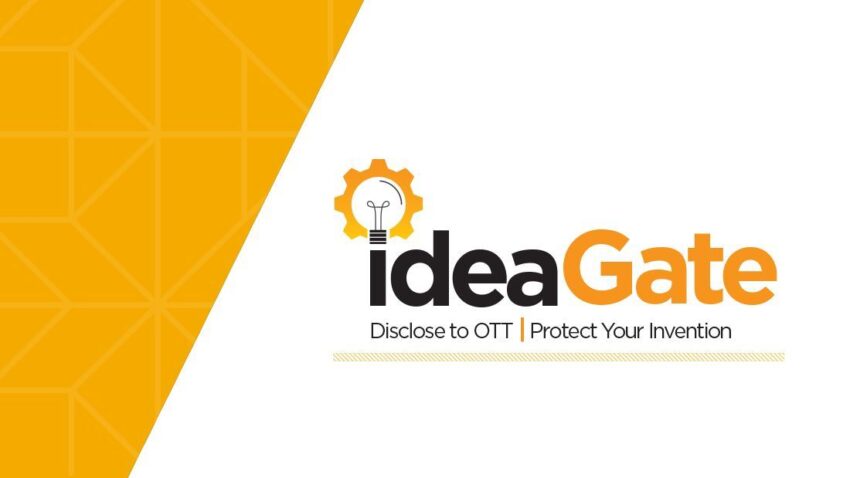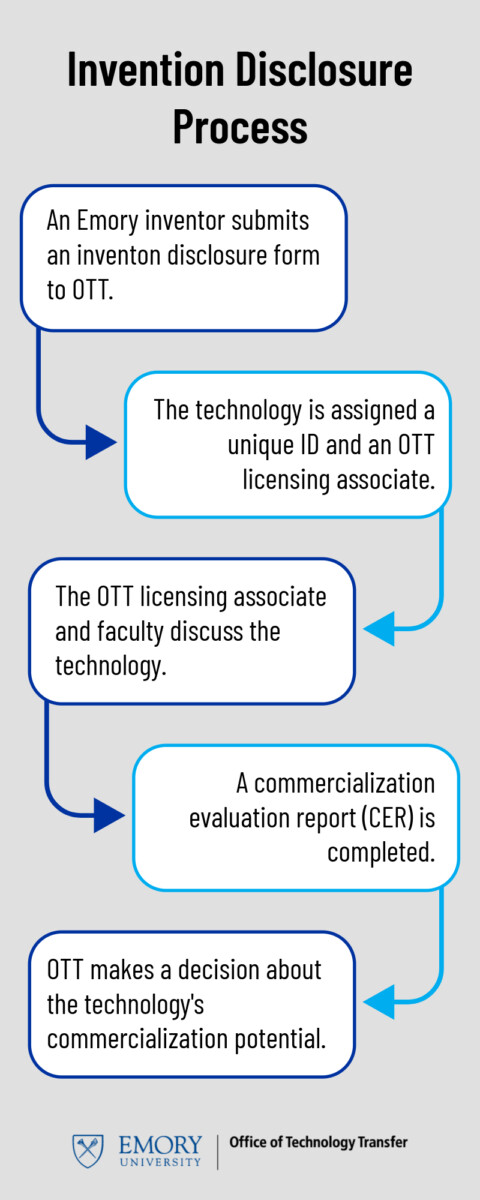A faculty member has a great invention. They submit an invention disclosure. What happens next?
Emory’s Office of Technology Transfer (OTT) is an Emory researcher’s first stop on the road to commercialization. From the moment a disclosure is submitted, our staff works to ensure a smooth and efficient process for all parties involved. Each invention disclosure is assigned a tech ID number and OTT licensing associate. The licensing associate will then have some initial conversations with the faculty member about their goals for the product or project and the type of funding surrounding their research.

Use IdeaGate to submit your invention disclosure.
From this point on, the licensing associate will take the reins and begin a commercialization evaluation report, or CER.
A CER is an analysis and documentation of the information necessary to decide how the office should proceed in terms of the product. It has three main components: a technology summary, a market summary, and a full IP search.
Technology Summary
A tech summary outlines the background information surrounding the technology and aims to give the office a comprehensive view on what problem the product is trying to solve. To do this, licensing associates detail the technology, understands the stage of development, and what type of technology it is. While working on the technology summary, licensing associates will also work with faculty to see if there is any important data that should be included and incorporated into the report.
Market Summary
The second aspect of a CER is the market summary, which contains all the research done by the licensing associates on the product’s potential market. This part of the report answers whether the market for the technology exists, and if it does, what that market looks like. To describe the market, the licensing associate researches how big the market is, how fast the market is growing, where the market is located, and what the competing technology looks like.
 Kaitlyn Taylor, a licensing associate at Emory OTT, explains, “If the technology is targeting a specific disease, we’ll research epidemiological information to find out how many people have it. We’ll also research the gold standard treatment for that type of condition to determine how it’s currently being treated so we can distinguish how the disclosed technology is different.”
Kaitlyn Taylor, a licensing associate at Emory OTT, explains, “If the technology is targeting a specific disease, we’ll research epidemiological information to find out how many people have it. We’ll also research the gold standard treatment for that type of condition to determine how it’s currently being treated so we can distinguish how the disclosed technology is different.”
Full Intellectual Property (IP) Search
A full IP search is the final piece to the initial CER. This search determines if there are other, similar inventions already in existence and if they have been patented yet. The search includes publications, art, and anything else that could be relevant to trying to get a patent for the invention.
Final steps
Once the licensing associate has completed this first report, they will bring the report to be discussed at the weekly staff techHuddle meetings. At the meetings, they will present both the research and their own recommendation for future steps regarding the invention. During this time, other members of the team can offer input and their own advice, which helps the office come to a well-rounded decision on how to move forward.
Moving forward with an invention falls into four buckets: file a patent application, no patent needed to commercialize, hold and revisit, and do not pursue. Licensing associates will relay all of these decisions back to the inventors, no matter the decision.
- File a patent application: The Emory Patent Group will begin the process of filing a patent for the invention.
- No patent needed to commercialize: The marketing department will promote the invention without a patent. (This usually happens with copyrighted technologies.)
- Hold and revisit: Often used when more data is needed for the office to make a more complete decision – usually when the invention has not been completely developed.
- Do not pursue: The office decides not to pursue a patent for an invention if similar prior art exists or if the invention does not meet the requirements of a patent.
While this process is intensive, the office is always happy to receive more invention disclosures (in fact, they receive over 200 each year), so file away!
Taylor emphasizes, “We always encourage faculty to disclose. If they [faculty] think they have something but they’re not sure, they should just go ahead and disclose.”
Ready to disclose your invention? Log into IdeaGate with your Emory NetID and password to submit!
— Eloise So
